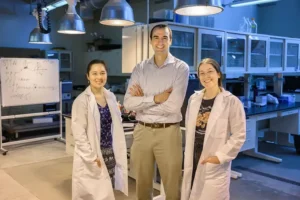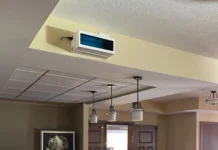By Liz Stevens, writer, UV Solutions
When designing a UV treatment for the disinfection of water and wastewater against bacteria such as Escherichia coli, a bacterium’s recovery characteristics – its ability to self-repair – must be considered. Part of gauging the recovery potential includes assessing the water’s post-disinfection environment for self-repair-conducive conditions. If these conditions are present in an environment, either the initial UV disinfection specifications or the post-disinfection environment (or both) can be adjusted to ensure more complete, lasting E. coli inactivation.
Variables in the water’s post-disinfection environment, such as the presence of light energy and the nutrient value of the water, must be taken into account to predict the duration of the disinfection treatment’s efficacy vis-a-vis the bacteria’s ability to carry out photoreactivation or dark repair. With these factors in mind, the aspects of the disinfection treatment that can be adjusted to mitigate the self-repair potential include the wavelength or multiple wavelengths of the disinfecting UV, the intensity of the UV exposure, the dosage of UV and whether the UV exposure is pulsed or non-pulsed. Additional treatment train steps, such as co-dosing with chlorine, also can be added or modified.
In addition to changes to the UV treatment itself and post-UV treatment steps, other modifications to the overall disinfection strategy can make a crucial difference. For example, relocating the water treatment site from the point of entry to the point of dispense can reduce the risk associated with photorepair.
The development of UV LED technology is proving to be useful for water disinfection research as well as its treatment. UV LED allows for easier, faster testing of UV wavelength/intensity/dosage/pulsed or non-pulsed exposure for best results in disinfection. The technology also facilitates easier, faster experimentation of potential solar UV conditions in water’s post-UV treatment storage, giving researchers the ability to explore and analyze photoreactivation and dark repair scenarios for the bacterial pathogens and microorganisms commonly found in water that is to be treated.

One of the researchers benefitting from UV LED technology is Andrea Martinez, application engineer, Americas at UV-C LED system manufacturer AquiSense Technologies of Erlanger, Kentucky. Martinez presented a poster, “Characterizing and modeling the parameters governing regrowth and photorepair of Escherichia coli after UV-C irradiation,” at the 2022 IUVA Americas Conference. The poster topic also was the subject of her Master’s thesis at Louisiana State University and Agricultural and Mechanical College, where Martinez received her Master of Civil Engineering in spring of 2023.
At AquiSense, Martinez builds upon her Louisiana State research into this important topic. “Most microorganisms have the ability to repair some UV-induced DNA damage, via either dark repair pathways or photorepair enzymatic activity,” Martinez explained. “This capability has been documented in multiple pathogens of concern to public health. Although the repair of microbes has been a known mechanism by the scientific community for a while, only recently have steps been taken to understand the parameters that impact this phenomenon, as well as how much risk this issue poses to human health and public safety.”
Martinez stated that UV LED technology has become a valuable tool for exploring bacterial dark repair and photoreactivation, and for addressing the problem. “UV-C LED technology opens a wide array of possibilities to minimize the risk from this phenomenon,” said Martinez. “The variability of wavelength, as well as the ability to pulse, allows for better understanding of the impact that different conditions have on dark and light repair, as well as possible mitigation strategies.”
While much is known about the disinfection power of UV light, the science is not as mature regarding bacteria self-repair and the environmental conditions that can support or thwart it. “The mitigation of photoreactivation and dark repair,” said Martinez, “has been demonstrated to be successful when increasing the UV dose. However, in contexts where increasing the UV dose is not feasible, it is important to learn whether other parameters impact how bacteria can repair from UV-induced DNA damage.” Her research as a grad student at LSU focused on this perspective. “We wanted to further understand what parameters play a role in how much repair is observed from bacteria, and how we could potentially mitigate it.”
At AquiSense, Martinez continues her investigations. “The company has a broad range of lab-scale products that foster innovative UV-C LED research worldwide,” she said. The insights gained so far have been illuminating, but more research is required to identify the scope of the problem and methods to mitigate bacterial self-repair. “Although photoreactivation is something that we should not dismiss,” said Martinez, “research has yet to establish how at-risk the general population is to contamination in different applications. There still are no set findings that point to specific changes to be made. However, it does point us to best practices, such as point-of-dispense being the safest option for UV disinfection applications.”
At AquiSense, Martinez also is working on several research projects as a partner with universities and other organizations. The projects span collaborations with Dalhousie University for industrial and municipal scale UV-LED systems to pharmaceutical and space applications of UV LED disinfection. “I am working with a pharmaceutical company to develop new products for cleanroom applications,” she said. “I also am working on an exciting project with NASA that investigates the disinfection performance of UV-C LEDs on space applications.” While at Louisiana State University, Martinez’s research did not expand beyond E. coli but the research collaboration that she currently is managing between AquiSense and Dalhousie University has expanded to other microbes.
Martinez seems to have found a very good home for her skills and interests at AquiSense. “I joined AquiSense because I believe in the mission of the company,” she said, “as well as the future of the technology. Working with UV-C LEDs during graduate school gave me the insight into the possibilities that this technology opens for water safety and access to clean water for more people. Understanding the technology was a big part of why the role seemed like a great fit.”
Growing up in Latin America, Martinez had first-hand experience of how disparity in water access in different communities impacts development. “Working at AquiSense,” she said, “I have had the opportunity to work with organizations, such as Isla Urbana, that work to bring clean water to children in marginalized communities in Mexico.”
With help from technology like UV LEDs, Martinez is poised to use her knowledge and passion to make a difference and to take strides toward a world where fresh, clean water is available to everyone.
For more information, email Martinez at andrea.martinez@aquisense.com.





